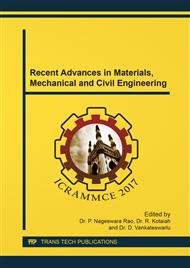p.54
p.60
p.66
p.82
p.87
p.92
p.98
p.104
p.110
FEM of ECDM Process on Semi Conducting Materials
Abstract:
Electro Chemical Discharge Machining (ECDM) process has been developed as an innovative machining process for machining non-conductive materials. The various application of this hybrid process is used in many industries like nuclear, medical and automobile industries. The scope of ECDM in micro machining of semiconducting materials is still found to be promising challenge for researchers. Due to many advanced properties of silicon, its use in MEMS industries is enormous. Many researchers have carried out lot of empirical estimation for discharges in ECDM. However very less work has been reported in the modelling of the ECDM process. Present work mainly concentrates on Finite Element Modelling (FEM) of micro holes machined on silicon wafers with ECDM process. A thermal FEM of spark discharge in the ECDM is carried out. The results from FEM are compared with experimental results and are found to be satisfactory. The model developed can be used for prediction of MRR for a particular combination of workpiece-tool arrangement.
Info:
Periodical:
Pages:
87-91
Citation:
Online since:
February 2018
Authors:
Price:
Сopyright:
© 2018 Trans Tech Publications Ltd. All Rights Reserved
Share:
Citation:


